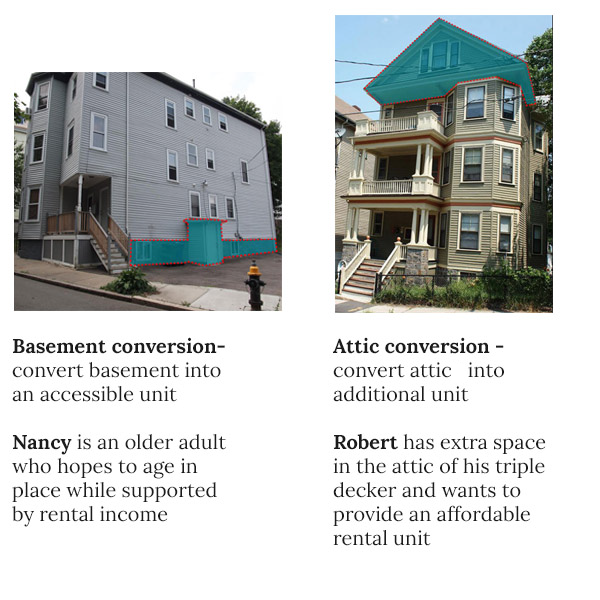Additional Dwelling Unit Program
Learn how to move forward with the process of adding an additional dwelling unit (ADU) to your property. You can also apply for a 0% loan to build your approved design.
The Additional Dwelling Unit Program allows owner occupants in the City of Boston to carve out a new space within their homes. They can create smaller, independent units, known as Additional Dwelling Units (ADUs) once the design has been approved. For those who qualify, we offer loans to build approved ADU designs.
To learn more about the ADU Pilot Program, including goals and lessons learned, visit the ADU Pilot Program page.
To stay up to date on the next steps of the ADU program — including ADU 2.0 for homeowners interested in turning existing exterior structures like carriage houses and underutilized garages into livable space — sign up for the email list.
Eligibility
You must meet these requirements to qualify for the Additional Dwelling Unit Program.
- Own a 1-, 2- or 3-family home within the city of Boston
- Live in that same home
- Plan to build your ADU in that same home
- Plan to build your ADU within the footprint of your home
- Plan to build your ADU above the Base Flood Elevation (BFE) if your home is in the FEMA Flood Zone, and you want to build a basement or first floor unit
Designing Your ADU
The City of Boston Staff who run the ADU Workshop have put together an Informational video about the program.
There are many ways to design and build your ADU. This section includes some important design tips and strategies. Our goal is to make this design process accessible to all homeowners through some general advice and guidance.
Building Code Requirements Basics
Below are some important code and other design considerations for ADUs. There must be:
- a full unit, which includes a bathroom and kitchen
- two means of egress, which are ways for people to exit the building
- water and electricity shutoff valves accessible to all units
- compliant ceiling height, especially for basement and attic units, and
- a sprinkler added in the new unit if you have 2- or 3-family home.
Find more Building Code requirements in the How to Apply for an ADU Permit section.
The unit cannot involve any bump out, extension, or construction to the existing envelope of the structure that results in the addition of gross floor area. Exterior work is allowed as long as the interior building square footage stays the same.
To help with your planning, view the checklist.
How to Apply for an ADU Permit
How to ApplySince an additional dwelling unit is classified as an independent unit, it must be inspected as such. A unit should comply with all building and sanitary codes.
Code and design considerations for ADUs include:
- a full unit, which includes a bathroom and kitchen,
- two ways for people to exit the building,
- water and electricity shutoff valves accessible to all units,
- compliant ceiling height, especially for basement and attic units, and
- a sprinkler added in the new unit if you have a 2- or 3-family home.
We can discuss code and design considerations particular to your home at the ADU Design Workshop. To help with your planning use the ADU checklist.
Before you can apply for an additional dwelling unit permit, you need to develop plans for the unit you want to build.
- Create preliminary designs or drawings of your proposed unit
- Prepare a description of your additional dwelling unit
- Take pictures of the current space
- Get a cost estimate
A professional architect or contractor can help you at any stage of the process.
The ADU design workshops are currently being held digitally on the first Thursday of each month, from 4pm to 5:30pm. To receive the link to the virtual meeting, please click on the “Sign Up To Attend” button below and make sure to enter your email address.
Plans will only be reviewed if they have been submitted online through the “Sign Up To Attend” button below. Workshop attendees are encouraged to view this 50-minute ADU information session before the workshop.
Before you can start construction, you will need to get a long-form permit from the Inspectional Services Department. Click the how-to guide below for more information.
An additional dwelling unit used as a rental must be registered in accordance with Ch. 9-1.3 of the City of Boston Rental Registry Ordinance at the time of conversion.
Why DID the City start this program?
Additional dwelling units will increase affordable housing options in the City. We want to create safer living arrangements and support multigenerational family arrangements. Our goal is to provide more chances for homeowners to age in place and stay in their homes. An additional dwelling may provide needed income, or a place for a supportive relative to live, or a place with more accessibility for the homeowner. These units offer an opportunity to use existing infrastructure to achieve the City’s housing goals.
What if I sell my home?
If the new owner would like to use the additional dwelling unit as a rental unit, they will need to live on the property. They also must continue to register the unit with the rental registry.
What if there is already an unpermitted additional unit in my home?
We want to help homeowners bring existing units up to code. If you are eligible for the program, and your current unit can meet all of our criteria, you can apply to have it permitted as a rental unit.
What do I do if my property is in the FEMA Flood Zone?
You must be able to show that the lowest elevation of the building (the "Top of Bottom Floor" on your elevation certificate) is above the Base Flood Elevation (BFE) to be eligible for the ADU program. An Elevation Certificate will show the BFE. You may want to check your mortgage documents for this information. If you need to obtain an Elevation Certificate for your property, Elevation Certificates are prepared and certified by:
- a Licensed Land Surveyor
- Registered Professional Engineer, or
- Registered Architect who is authorized by state or local law to certify elevation information.
There is a useful FEMA website that explains:
- what an Elevation Certificate is, and
- how to get one for your property.
Once you obtain an Elevation Certificate for your property, please include it with your application. If you need additional advice, attend an ADU design workshop.
Who can I talk to if I have additional questions?
For general questions about the design of your ADU, sign up to attend an ADU design workshop. For questions about getting an ADU permit, contact the Inspectional Services Department.
What About Exterior ADUs?
Are you interested in ADU 2.0 (to create an ADU within an existing exterior structure such as carriage houses or garages)? Please feel free to attend the monthly ADU workshops if you have any questions.
While there is no zoning relief at this time, our team remains interested in identifying the next phase of the program. To stay up to date on the future of the ADU program, sign up for the email list.
How to Apply for an ADU Loan
We offer loans through our Additional Dwelling Unit Loan Program. The loans are interest-free and offer gap funding to eligible Boston homeowners who wish to create an ADU in their homes in the City of Boston.
- You might qualify to receive a loan up to $50,000 for an ADU project to owners of single-to three family homes.
- We base the amount of your loan on the estimated cost of the project.
- The loan has no monthly payments and does not become due until the owner sells, transfers ownership, or undertakes a cash-out refinance of the home.
For more program information, we created a fact sheet available in English, Español, Português, 中文, Français, Kriolu Kabuverdianu, Kreyòl ayisyen, Soomaali, русский, Tiếng Việt, or عربى.
- Check to make sure you are eligible for the ADU program.
- Get an ADU permit from the Inspectional Services Department (ISD) before you can receive an ADU loan.
- Prepare a description of your ADU.
- Take pictures of current space.
- Get a cost estimate.
- Create preliminary designs and drawings of your ADU.
COMPLETE THE APPLICATION FOR THE ADU LOAN PROGRAM
Also available in Spanish (Español), Portuguese (Português), Chinese (中文), French (Français), Cape Verdean Creole (Kriolu Kabuverdianu), Haitian Creole (Kreyòl ayisyen), Somali (Soomaali), Russian (русский), Vietnamese (Tiếng Việt), and Arabic (عربى).
You will be contacted by a program manager who will assist you through the process.
We'll give you a commitment letter and schedule a loan closing, if we approve your loan. Once you have closed on the loan, you can sign an agreement with your contractor and they can get a building permit.
You’ll need to give us a final invoice from your contractor and a copy of your building permit. We’ll set up a final walkthrough to make sure all the work was done.
You have to pay us back based on the terms of the loan.





